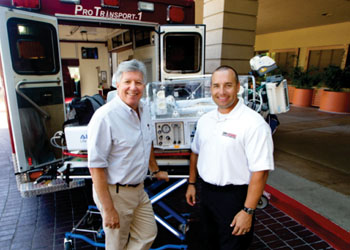New System Simplifies Emergency Patient Transfers
By HospiMedica International staff writers
Posted on 16 Apr 2015
A new electronic medical record (EMR) system helps make patient transport to other facilities safer and more efficient in the event of a major crisis, such as an earthquake or power outage.Posted on 16 Apr 2015
Developed by researchers at Stanford University (CA, USA) the triage by resource allocation for inpatients (TRAIN) program helps determine what vehicles and equipment are necessary for continuous patient care during a crisis event, as well as simplifying communicating patients’ needs to other hospitals or command centers coordinating transfers. Using the system, caregivers have prompt access to a fully automated report that categorizes patients in terms of their specific needs, such as what medication they receive, whether they are on ventilators, if they need intravenous (IV) lines, or whether they require an intensive care unit (ICU) bed.

Image: Ronald Cohen, MD, and Brandon Bond (Photo courtesy of Norbert von der Groeben/ Stanford).
Under TRAIN, all patients are assigned a color. For example, patients that need specialized transport, such as an ambulance or military vehicle, in addition to life-support equipment, such as ventilators and multiple intravenous drips for medication, can be categorized instantly with a single word: red. In comparison, patients marked with blue tags are considered stable and can be transported in a car or bus, without any specialized equipment. TRAIN thus allows care teams to communicate the medical needs of the specific patient, as well as the severity of his or her condition.
“We can see exactly what resources are needed for each patient at all times. Should we have to evacuate, which we hope we never have to do, TRAIN puts us far ahead in terms of keeping our patients safe during an incident,” said Brandon Bond, director of the office of emergency management for the hospitals at Stanford. “We can see exactly what resources are needed for each patient at all times.”
“Once we had the algorithm, we knew our electronic medical record could easily calculate the TRAIN classification. Most importantly, the calculation could be done in an instant, without any additional work from doctors or nurses,” said Ronald Cohen, MD, clinical professor of neonatal and developmental medicine at Stanford school of medicine. “The computer system automatically categorizes patients based on their needs, and that report is always on hand. This would take hours to do manually, but it’s now available instantly, 24 hours a day. It’s an extremely valuable tool that hopefully we’ll never need.”
TRAIN is based on the Epic (Verona, WI, USA) EMR, a fully integrated health care software platform that allows physicians and nurses to record the condition of every patient, with constant updates in real time.
Related Links:
Stanford University
Epic














